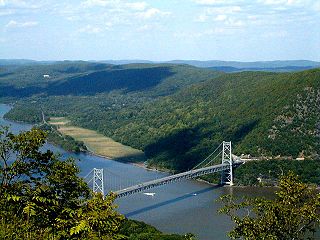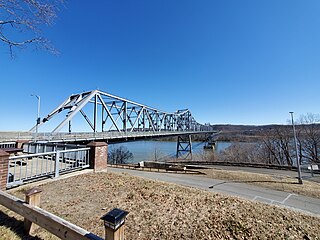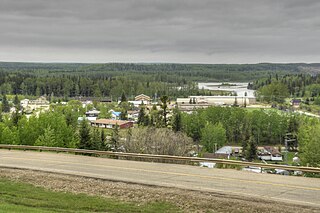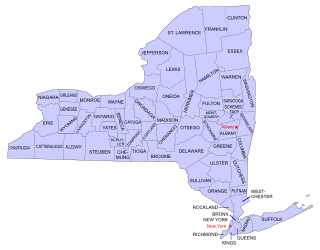For crossings of the Hudson River, see:
For crossings of the Hudson River, see:

The Hudson River is a 315-mile (507 km) river that flows from north to south primarily through eastern New York in the United States. It originates in the Adirondack Mountains of Upstate New York and flows southward through the Hudson Valley to the Upper New York Bay between New York City and Jersey City, eventually draining into the Atlantic Ocean at New York Harbor. The river serves as a political boundary between the states of New Jersey and New York at its southern end. Farther north, it marks local boundaries between several New York counties. The lower half of the river is a tidal estuary, deeper than the body of water into which it flows, occupying the Hudson Fjord, an inlet which formed during the most recent period of North American glaciation, estimated at 26,000 to 13,300 years ago. Even as far north as the city of Troy, the flow of the river changes direction with the tides.

James Bay is a large body of water located on the southern end of Hudson Bay in Canada. Both bodies of water extend from the Arctic Ocean, of which James Bay is the southernmost part. It borders the Canadian provinces of Quebec and Ontario. Islands within the bay, the largest of which is Akimiski Island, are part of Nunavut.
The Hamilton Fish Newburgh–Beacon Bridge is a cantilever toll bridge that spans the Hudson River in New York State. The bridge carries Interstate 84 (I-84) and New York State Route 52 (NY 52) between Newburgh and Beacon. Consisting of two separate spans, the original northern span which carries westbound traffic, was opened on November 2, 1963, as a two-lane bridge. A second span completed in 1980, now carries all eastbound traffic. Still often referred to by its original name, the Newburgh–Beacon Bridge, in 1997 the bridge was rededicated in honor of Hamilton Fish III, a 12-term member of the U.S. House of Representatives, and his son and namesake Hamilton Fish IV, a 13-term member of the House.

The Bear Mountain Bridge, ceremonially named the Purple Heart Veterans Memorial Bridge, is a toll suspension bridge in New York State. It carries US 6 and US 202 across the Hudson River between Bear Mountain State Park in Orange County and Cortlandt in Westchester County. At completion in 1924 it was longest suspension bridge in the world until this record was surpassed 19 months later by the Benjamin Franklin Bridge between Philadelphia and Camden, New Jersey. The Bear Mountain Bridge is unconventional among suspension bridges: though its main span is suspended by cables in the usual manner, the approach spans do not have suspender cables and are instead unsuspended trusses, like the Williamsburg Bridge in New York City.

The Rip Van Winkle Bridge is a 5,040 ft (1,540 m) cantilever bridge spanning the Hudson River between Hudson, New York and Catskill, New York. Affording 145 feet (44 m) of clearance over the water, the structure carries NY 23 across the river, connecting US 9W and NY 385 on the west side with NY 9G on the east side. The bridge is named after the 1819 short story of the same name by Washington Irving, which mentions Hudson and Catskill.

The Franklin Delano Roosevelt Mid-Hudson Bridge is a toll suspension bridge which carries US 44 and NY 55 across the Hudson River between Poughkeepsie and Highland in the state of New York.

Fort Assiniboine is a hamlet in northwest Alberta, Canada, within Woodlands County. It is located along the north shore of the Athabasca River at the junction of Highway 33 and Highway 661. It is approximately 39 kilometres (24 mi) northwest of Barrhead, 62 kilometres (39 mi) southeast of Swan Hills and 91 kilometres (57 mi) northeast of Whitecourt.

Howse Pass is a pass through the Rocky Mountains in Canada. The pass is located in Banff National Park, between Mount Conway and Howse Peak. From here waters flow east via Conway Creek, Howse River, North Saskatchewan River to Lake Winnipeg and Hudson Bay. To the west it drains by the Blaeberry River to the Columbia River and on to the Pacific Ocean.

The George Clinton Kingston–Rhinecliff Bridge is a continuous under-deck truss toll bridge that carries NY 199 across the Hudson River in New York State north of the City of Kingston and the hamlet of Rhinecliff. It was opened to traffic on February 2, 1957 as a two-lane bridge, although it was not actually complete. The formal opening was May 11, 1957. The original cost was $17.5 million.

Buildings, sites, districts, and objects in New York listed on the National Register of Historic Places:
The Newark Plank Road was a major artery between Hudson Waterfront at Paulus Hook and city of Newark further inland across the New Jersey Meadows. As its name suggests, a plank road was constructed of wooden planks laid side-to-side on a roadbed. Similar roads, the Bergen Point Plank Road, the Hackensack Plank Road and Paterson Plank Road, travelled to the locales for which they are named. The name is no longer used, the route having been absorbed into other streets and freeways.

Hawthorne is a railroad station operated by New Jersey Transit in the borough of Hawthorne, Passaic County, New Jersey, United States. It is the northernmost station in Passaic County along New Jersey Transit's Main Line. Trains coming through Hawthorne service Waldwick, Suffern and Port Jervis to the north and Hoboken Terminal to the south, where connections are available to New York City via Port Authority Trans-Hudson and ferries. The station, accessible only by Washington Place in Hawthorne, contains only two low-level platforms connected by a grade crossing. As a result, the station is not compliant with the Americans with Disabilities Act of 1990.

The Bennington Battlefield is the Rensselaer County, New York, location where the Battle of Bennington occurred on the 16th of August 1777. It is located on New York State Route 67 in Walloomsac, New York, a historic route between Bennington, Vermont and the Hudson River. Here, New Hampshire, Vermont and Massachusetts militia under General John Stark rebuffed a British attempt led by Colonel Friedrich Baum to capture American stores. It was declared a National Historic Landmark in 1961. A portion of the battlefield is preserved in the Bennington Battlefield State Historic Site.

Dock Bridge is a pair of vertical lift bridges crossing the Passaic River at Newark, Essex County and Harrison, Hudson County, New Jersey, United States, used exclusively for railroad traffic. It is the seventh crossing from the river's mouth at Newark Bay and is 5.0 miles (8.0 km) upstream from it. Also known as the Amtrak Dock Vertical Lift, it carries Amtrak, NJ Transit, and PATH trains. It is listed on the state and federal registers of historic places.

The Maritje Kill is a tributary of the Hudson River in Hyde Park, New York. Its source is three miles northeast of the village of Hyde Park, and it enters the Hudson at the Hyde Park campus of the Culinary Institute of America (CIA). The river's name uses an old Dutch version of the given name Marietje, meaning "little Mary". It is one of two major waterways in Hyde Park, and flows north to south through the town.